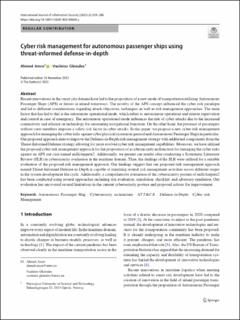| dc.contributor.author | Amro, Ahmed Walid | |
| dc.contributor.author | Gkioulos, Vasileios | |
| dc.date.accessioned | 2023-03-14T07:33:32Z | |
| dc.date.available | 2023-03-14T07:33:32Z | |
| dc.date.created | 2022-12-01T12:38:41Z | |
| dc.date.issued | 2022 | |
| dc.identifier.citation | International Journal of Information Security. 2022, . | en_US |
| dc.identifier.issn | 1615-5262 | |
| dc.identifier.uri | https://hdl.handle.net/11250/3058045 | |
| dc.description.abstract | Recent innovations in the smart city domain have led to the proposition of a new mode of transportation utilizing Autonomous Passenger Ships (APS) or ferries in inland waterways. The novelty of the APS concept influenced the cyber risk paradigm and led to different considerations regarding attack objectives, techniques as well as risk management approaches. The main factor that has led to this is the autoremote operational mode, which refers to autonomous operations and remote supervision and control in case of emergency. The autoremote operational mode influences the risk of cyber attacks due to the increased connectivity and reliance on technology for automating navigational functions. On the other hand, the presence of passengers without crew members imposes a safety risk factor in cyber attacks. In this paper, we propose a new cyber risk management approach for managing the cyber risks against cyber physical systems in general and Autonomous Passenger Ships in particular. Our proposed approach aims to improve the Defense-in-Depth risk management strategy with additional components from the Threat-Informed Defense strategy allowing for more evolved cyber risk management capabilities. Moreover, we have utilized the proposed cyber risk management approach for the proposition of a cybersecurity architecture for managing the cyber risks against an APS use case named milliAmpere2. Additionally, we present our results after conducting a Systematic Literature Review (SLR) in cybersecurity evaluation in the maritime domain. Then, the findings of the SLR were utilized for a suitable evaluation of the proposed risk management approach. Our findings suggest that our proposed risk management approach named Threat-Informed Defense-in-Depth is capable of enriching several risk management activities across different stages in the system development life cycle. Additionally, a comprehensive evaluation of the cybersecurity posture of milliAmpere2 has been conducted using several approaches including risk evaluation, simulation, checklist, and adversary emulation. Our evaluation has uncovered several limitations in the current cybersecurity posture and proposed actions for improvement. | en_US |
| dc.language.iso | eng | en_US |
| dc.publisher | Springer | en_US |
| dc.rights | Navngivelse 4.0 Internasjonal | * |
| dc.rights.uri | http://creativecommons.org/licenses/by/4.0/deed.no | * |
| dc.title | Cyber risk management for autonomous passenger ships using threat-informed defense-in-depth | en_US |
| dc.title.alternative | Cyber risk management for autonomous passenger ships using threat-informed defense-in-depth | en_US |
| dc.type | Peer reviewed | en_US |
| dc.type | Journal article | en_US |
| dc.description.version | publishedVersion | en_US |
| dc.source.pagenumber | 0 | en_US |
| dc.source.journal | International Journal of Information Security | en_US |
| dc.identifier.doi | 10.1007/s10207-022-00638-y | |
| dc.identifier.cristin | 2087002 | |
| cristin.ispublished | true | |
| cristin.fulltext | original | |
| cristin.qualitycode | 2 | |

